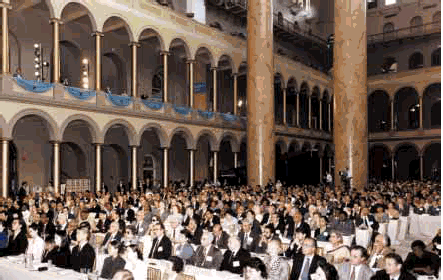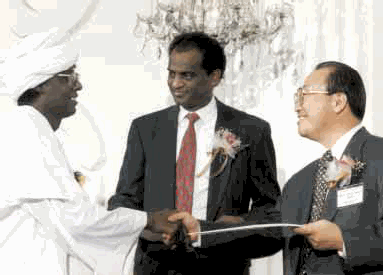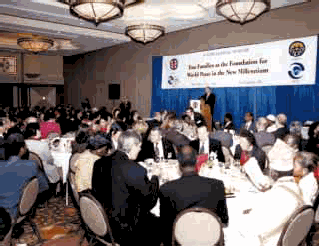
40 Years in America

|
|
40 Years in America |
|
Federations for World Peace and Unification

Participants at the Inauguration of the Family Federation for Unification and World Peace, Washington, D.C.
During the early 1990s, the movement was optimistic about the prospects for immanent, substantial world peace and unification. To some extent, its perspective mirrored that of secular idealists who in the wake of the West’s cold war victory proclaimed "the end of history." However, there was one important difference. Secular optimists tended to perceive the post-cold war situation in terms of the triumph of democratic values. Unificationists, however, rested their hopes upon the victory of True Parents who were regarded as the true "end" of history. Both of these positions were put to the test during the 1990s. In the wider society, there was a loss of idealism during the middle years of the decade as the costs of winning the peace became more apparent. There also was a tendency to retreat into isolationism and self-indulgence.
Unificationists were not oblivious to these pressures, but the movement as a whole stayed the course, pursuing a three-pronged program of world peace and unification. The first component of this program was dialogue. Rev. Moon remained convinced that interdisciplinary, intercultural and inter-religious dialogue was essential for world peace. Therefore, the movement continued to sponsor a broad array of conferences. The defining characteristic of this development during the 1990s was the proliferation of numerous "federations for world peace." These integrated the distinct and separate organizations for scientists, academics, media professionals, religious leaders, politicians and the like which the movement had previously organized and funded. This shift actually began in the previous period with the establishment of the International Federation for World Peace (IFWP), the Inter-religious Federation for World Peace (IRFWP), and the Women’s Federation for World Peace (WFWP) in 1992. By the late 1990s, the movement proliferated a dozen or more federations. Many of them were later integrated under the International and Inter-religious Federation for World Peace (IIFWP).
Each of these federations appealed to a different constituency. However, they were interrelated and at least initially understood to be successors to the United Nations. Just as the victorious countries created the League of Nations following World War I and the United Nations after World War II, so the conclusion of the Cold War, which the movement perceived as World War III, required the creation of institutions reflective of the new era. In the immediate afterglow of communism’s collapse and in the context of references to a new world order expressed by some world leaders, the movement sensed that a new federative body would supersede the United Nations. As the idealism and hopes of the early 1990s faded for many, the movement re-conceptualized the mission of its peace federations: rather than superseding the United Nations, they would work to revitalize it.
The federations for world peace also presupposed a more focused commitment among participants. Previously, those attending ICUS, PWPA, World Media Association, AULA or Summit Council meetings were united in their general affirmation of theistic values and opposition to communism. Although there was a higher degree of interdisciplinary encounter, civility and even family feeling than elsewhere, the conferences did not differ markedly in their basic orientation from professional meetings. There typically was a Founder’s Address at major gatherings, but otherwise attendees were exhorted to be the best professionals and persons they could be. Rev. Moon’s declaration of messiahship to an assembled gathering of conference participants at the first World Sports and Culture Festival in 1992 altered the equation, but there was still the possibility of proceedings slipping back into business-as-usual. In this regard, the creation of peace federations called participants beyond pre-existing professional and personal involvements to a shared common cause and a more activist, existential encounter. Another feature that the federations had in com- mon was Western and particularly American influence. The working staff, meeting chairs, and the great bulk of the keynote speakers were Western, usually American. English was the language of choice for international gatherings, and the organizational structure and proceedings were governed by Western cultural norms.
Despite these influences, funding came from the Orient, and the federations were subject to the movement’s sense of timing and purpose. Many of the major international meetings were held in conjunction with movement-sponsored World Culture and Sports Festivals and to some extent served as a backdrop to the International Blessings. However, this was not uniformly the case. The movement’s most spectacular world convention was held in Washington, D.C. from July 30-August 1, 1996, inaugurating the Family Federation for World Peace (FFWP). This event included a cast of luminaries rivaling anything the movement had yet undertaken: two former Presidents of the United States, Gerald Ford and George Bush; former President and Nobel Peace Prize winner Oscar Arias of Costa Rica; former Prime Ministers Edward Heath of Great Britain and Brian Mulroney of Canada; thirty-six one-time heads of state or governments; university presidents including Boston University’s John Silber; Christian television personality Robert Schuller; Christian Coalition Executive Director Ralph Reed; Coretta Scott King, the widow of Martin Luther King, Jr.; Maureen Reagan, the daughter of former U.S. President Ronald Reagan; well-known comedian Bill Cosby; and Christian singer-actor Pat Boone. In addition, the main proceedings were covered live by C-SPAN television network.
The Washington Post contended that some of the speakers were unaware of Rev. Moon’s involvement and cited critics who claimed that former presidents, celebrities and educators recruited to speak at World Peace conventions were being used. The Post also speculated about speaker fees. Movement spokespersons stated that they took great pains to let everybody know who founded the FFWP, emphasized that the conference was meant to attract former heads of state who still wield influence in order to put family matters at the top of the agenda in their nations, and noted that the size of honorariums paid to speakers was confidential. Far from using them, Rev. Moon understood that his ministry had progressed to the point that world-level leaders were his peers and an appropriate audience for him to address. Also, Mrs. Moon delivered a straightforward opening plenary speech on the "View of the Principle of the Providential History of Salvation." In this respect, the Inaugural World Convention of the FFWP was a high-level witnessing opportunity.
The establishment of the FFWP represented a new stage in the movement’s development. Rev. Chung Hwan Kwak, who was appointed International President, maintained that the FFWP was more important than the Holy Spirit Association for the Unification of World Christianity (HSA-UWC) or Unification Church. HSA-UWC, he noted, was "not True Parents’ ultimate organization." The rationale for this assertion was connected to the historic shift that underlay the emergence of the Completed Testament Age. As noted previously, Rev. Kwak explained,
Religious organizations have always been centered upon the salvation of the individual, but we have now progressed to the salvation of the family.... Such an organization is not a church; it is the Family Federation for World Peace.
Given this understanding, it wasn’t surprising that the FFWP rather than the Unification Church was the main sponsor of the World Culture and Sports Festivals and International Marriage Blessings after 1996.
By the late 1990s, the movement proliferated a dozen or more federations for world peace. Some of them were quite specific, i.e., the Artist Association for World Peace (est. 1995), Island Nations for World Peace (est. 1996), Peninsula Nations for World Peace (est. 1996), Continental Nations for World Peace (est. 1996), Martial Artists for World Peace (est. 1997). In addition, the movement sponsored a World Peace Conference for several years and inaugurated a World University Federation. Within this constellation of activity, the Inter-religious Federation for World Peace (IRFWP) and the International Federation for World Peace (IFWP) functioned as umbrella organizations, representing internal and external approaches to the solution of world problems.
These two federations coalesced into a single entity, the Inter-religious and International Federation for World Peace, in 1999. The stated purpose of the merger was to bring their combined resources together.

Rev. Chung Hwan Kwak and Taj Hamad (center) congratulating a graduate of an inter-religious seminar at the New Yorker Hotel
This process began with a conference on "Realizing the Interfaith Ideal: Action Beyond Dialogue" sponsored by the IRFWP in Washington, D.C. from December 18-20, 1998. The "concept for the conference," according to its coordinator Dr. Frank Kaufmann, "revolved around an initiative for religious leaders to work formally with the United Nations," a vision which "was enthusiastically received by the 126 international participants in attendance." Even more gratifying was the response of United Nations representatives present who "acknowledged the conference initiative as inspired, timely, necessary and doable." Rev. Chung Hwan Kwak in an important plenary address, "New Directions for Interfaith," stated,
[W]orld peacemaking calls not only for the wisdom of statesmen and diplomats but also for the wisdom of the world’s religions, as embodied in the most honored representatives of those religious traditions. To implement such a program would involve a re-structuring of the UN as currently conceived. For, in addition to the representation of nation states, there would be representatives of the world’s religious traditions.
One can perhaps imagine a congress of two houses. One house -- a House of Representatives -- would be structured very much as the existing United Nations. It would consist of an assembly of wise and experienced representatives of the world’s national governments. In addition to this house, however, there would be added a second house or senate. This Senate would consist of distinguished religious leaders. Together, in a spirit of mutual respect and cooperation, these two houses would work together with a single objective: moving the world toward peace.

A Hoon Dok Hae Conference in Washington, D.C., 1999
Rev. Kwak’s sentiments reflected those of Rev. Moon who had previously spoken along these lines. In his conference address, Rev. Moon stated, "the path to world peace will be incomplete if we build it merely upon the political, economic and military functions of the United Nations.... I hope the participants here today, and all the nations of the world, will seriously consider this proposal to establish a structure encompassing the world’s religions and the United Nations."
The call to religious leaders for "action beyond dialogue" continued with the establishment of the Inter-religious and International Federation for World Peace (IIFWP) in February 1999. However, it was supplemented by another theme. According to Frank Kaufmann, a "second trademark insight" attributable to Rev. Moon was "his understanding of the seamless web linking family order to world order."
This was apparent in the IIFWP’s first and succeeding International Seminars in Washington, D.C. on "True Families as the Foundation for World Peace in the New Millennium." In early July 1999, Rev. Moon directed IIFWP staff to convene the first seminar "before the end of the month and to bring together two hundred distinguished participants representing more than forty nations" as well as participants from each of the twenty-two U.S. states in which Mrs. Moon had recently spoken. From each locale, three guests were to be invited: one a religious leader, one a political leader, and the other an academic leader.
Rev. Moon also gave "specific direction that the content of the conference program...should be dedicated to a series of Hoon Dok Hae readings." These were "gathering for reading and learning" sessions based on passages from Rev. Moon’s speeches. The general membership had been encouraged to practice Hoon Dok Hae between 6:00-7:00 a.m. since late 1997, but it had not been tried included a series of seven ninety-minute Hoon Dok Hae sessions, each consisting of a reading on a specific topic followed by responses by two assigned discussants and comments from the floor. Despite initial apprehensions, members with extensive experience in dialogues of this type offered glowing appraisals. Dr. Anthony Guerra, Dean of Undergraduate and Graduate Studies at the University of Bridgeport, commented,
I have been comparing in my heart and mind over the past few days this first Hoon Dok Hae conference with the many other Unification-centered seminars for VIP guests. The strongest metaphor I’m left with is that of the difference between the atomic bomb and conventional weapons. In this first Hoon Dok Hae conference, our guests and also we members, are challenged by the direct words of True Parents. In the atmosphere created...we all seem to be delivered from our old selves.... Father has given us the formula for Pentecost.
Given the success of the initial gathering, the movement undertook regular Hoon Dok Hae conferences for the remainder of the year in Washington, D.C. Beginning with the second conference on September 17-20, media representatives were included among the religious, political and academic leaders.
The introduction of Hoon Dok Hae and the emergence of high-level conferences devoted to "reading and learning" Rev. Moon’s words highlighted two important points. First, Rev. Moon’s speeches or excerpts from his speeches were beginning to supplant The Principle as the movement’s official canon in the Completed Testament Age. For some, the Divine Principle was reduced in stature from a sacred text to a systematic theology. Moreover, it was regarded as being addressed primarily to Christian audiences. In this respect, Hoon Dok Hae was seen to underscore the "universalism" inherent in Rev. Moon’s message. Second, the study of Rev. Moon’s words on diverse topics related to the family and world peace was a clear indication that the movement pursued not only peace but also unification. In other words, it understood that true and lasting peace could not emerge without a central reference point. How explicit that reference point should be was open to interpretation. The Hoon Dok Hae conferences emphasized the "spiritual" and "internal aspects of the global peace process," i.e., "common values and shared concerns." Nevertheless, an unstated assumption behind the gatherings was that there could be no peace or unity among brothers and sisters at any level without True Parents.
Download entire page and pages related to it in ZIP format
Table of Contents
Information
Tparents Home